 Effective fundraising is a cornerstone of a sustainable organization and we know that many Alliance members are particularly focused on engaging supporters during this critical period of year-end giving. But with the deluge of asks this time of year, how can you make your organization’s achievements stand out — in the digital space of e-mails and social media?
Effective fundraising is a cornerstone of a sustainable organization and we know that many Alliance members are particularly focused on engaging supporters during this critical period of year-end giving. But with the deluge of asks this time of year, how can you make your organization’s achievements stand out — in the digital space of e-mails and social media?
On our latest Distance Learning Webinar, we asked two experts to share best practices in making your year-end appeal successful online. Our panelists included self-professed development nerd (and former League of American Bicyclists' Development Director) Lili Leonard, the Director of Development & Individual Giving at Whitman-Walker Health in Washington, D.C.; and APBP's 2015 Nonprofit Professional of the Year (and award-winning social media guru), Barb Chamberlain, Executive Director of Washington Bikes.
Here are some of their top take-aways for boosting your ROI and relationship-building online — watch the full recording of the webinar here.
And, hey, while we're on the topic... if you value webinars like this, please consider a year-end gift to the Alliance!
Lili Leonard, Director of Development and Individual Giving, Whitman-Walker Health
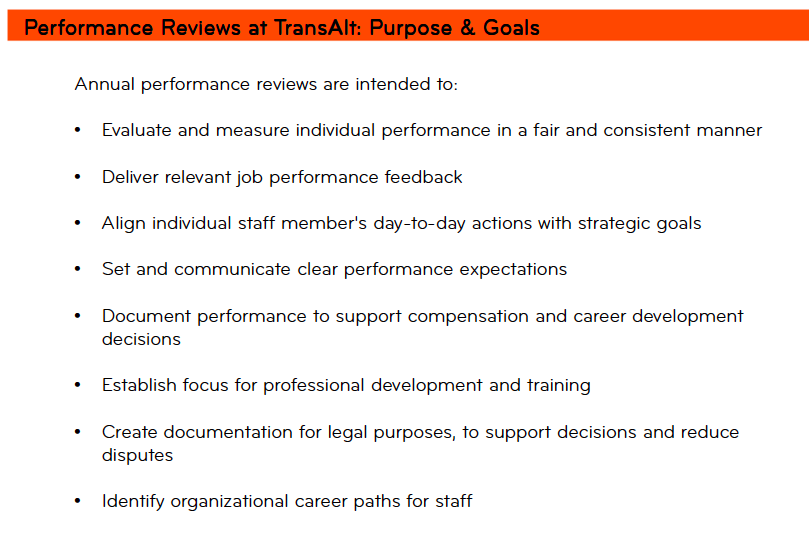
Identify your goals: Make sure you set some benchmarks and metrics for your appeal. "Especially if this is your first year [moving more aggressively into the digital fundraising space]," Leonard said, "it's important to know where you're starting, so next year, when you do it again, you can make incremental improvements."
Make the ask — and make it clear: "The number one reason people don’t give is because they're not asked," Leonard said. "Make sure your message is strong, and be clear that there is a need for funding. Be proud of the work you do and make sure you articulate what you're asking for."
Four types of messaging that work well: Leonard shared that she's had success with appeals that focus on...
- Personal stories: "My life was changed because of bicycling — and the work of XYZ Bike Advocacy. Here's why I make a gift each year..."
- Program-specific achievements: "We won a protected bike lane on Main Street, but we need your help to push for improvements citywide!"
- Political asks: "This year we stopped the Anti-Walking Bill, but we need your support to improve funding for pedestrians!"
- Matching gifts: "Awesome Donor is willing to match your gift dollar-for-dollar; make your gift go twice as far!" (Pro tip: Do you have a donor who typically gives you $1,000 anyway? Share your gratitude and ask them if they'd be willing to make that public as a match.)
Experiment with A/B testing: Find out what works for your donor base. Is e-mail enough? If so, you might be able to boost your net return by whittling down your print costs next year. If you have any flexibility, experiment as below...
Be consistent across platforms: In many cases, organizations send a direct mail appeal to a pool of donors or key prospects — and continue that campaign online to that audience and a wider population. If that's you, continue the theme of the paper mailing in the e-mail follow-ups and online promotion. "Use similar language and color schemes," Leonard advised. And don't send your follow-up emails until the print letter hits mailboxes.
MAKE YOUR DONATION PAGE EASY TO NAVIGATE: "This is in all caps because it's so important for your online appeal," Leonard said. "If you have five pages people have to click through, your abandon rate is going to be extraordinarily high. You want to make it very easy to donate, as seamless as possible. If you can get it down to one or two pages, that's fabulous."
Sexy subject lines matter: "Make sure you have a catchy, sexy subject line," Leonard said. "It's the first and often last chance you have to make an impression." If you can, A/B test your subject line. Send 100 emails with one subject line and another 100 with a different approach. "Test them out and see which one has a higher open rate, click-through rate, and spam rate," Leonard said. And then send the more effective subject line to the rest of the larger list.
Be ambitious but judicious with e-mails: "If you're sending 10 e-mails to the same list in the month of December, you're probably going to have a higher spam rate," Leonard advised, "and you don't want to beat your donors over the head." Look at a calendar now (if you haven't already). Be strategic. Don't send three emails in three days.
Suppress donors once they give: The last thing you want is to be a digital annoyance — to your donors. "Only send subsequent e-mails to people who have NOT yet made a gift," Leonard said. "If you can't pull folks who have already donated out of the list, make sure you include language like, 'If you've already given a gift, thank you,' in every single e-mail."
Celebrate all victories — large and small: "Donor fatigue is a real thing," Leonard said. "If you get 10 or 20 or 100 new donors through a social push or email campaign, that's incredible. Those are folks that are now in your database, in your pipeline. Those small victories should absolutely be celebrated."
Barb Chamberlain, Executive Director, Washington Bikes
Social is imperative: Make no mistake — the revolution will be Tweeted. And your appeal should be, too. "Bottom line: Yes, you need to do social because your folks are there," Chamberlain emphasized. "And it's a reinforcer for your print and e-mail campaigns."
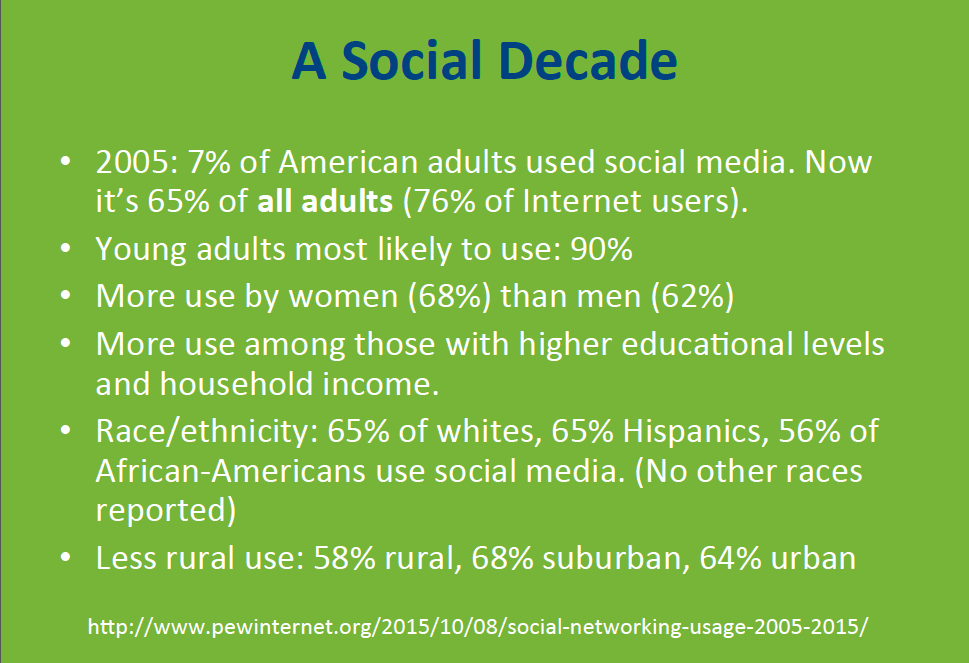
Yes, there are best practices for social media: Here are a few...
- ALWAYS include a visual. Whether on Facebook or Twitter, content that includes images is far more successful (and shared).
- Posting is a means to an end: "I don't think of social media as a stand-alone; use it as a way to build your email list," Chamberlain advised.
- Engage folks all year long: On social media, you're always telling your story — every day, all year-long — to build that connection and engagement that will inspire supporters to give when you ask.
- If it's not worth sharing, don't create it: Sharing is the lifeblood of social success. If your blog or ask isn't visual, inspiring and worth sharing, rethink that content.
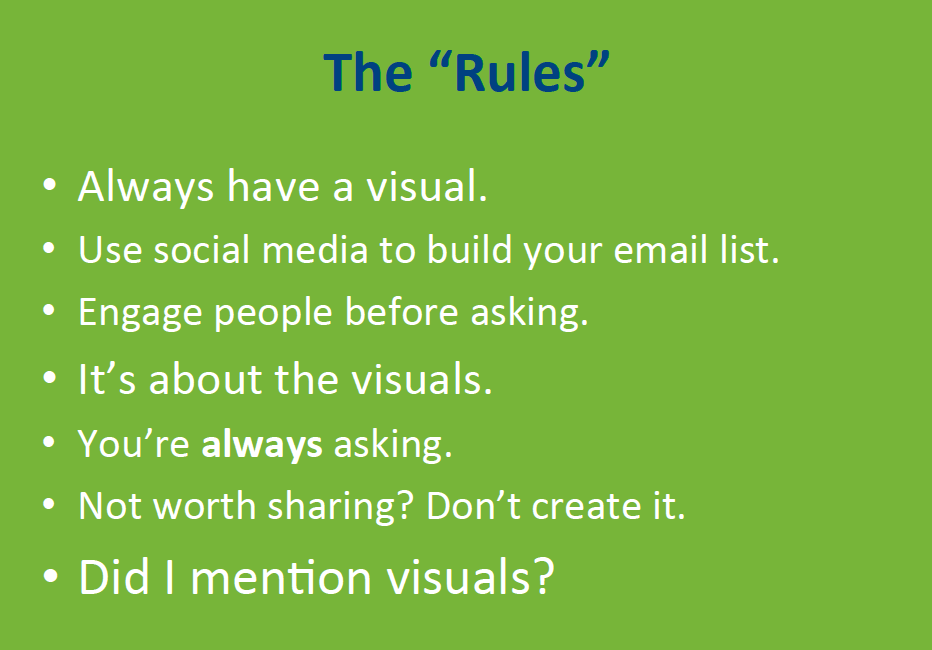 Visuals? What type of visuals? Well, as much as we love that wonky bill-signing picture, it probably won't get shared like a photo of what it means to your supporters: More happy, smiling families biking on a trail. "That's what you're striving for," Chamberlain said. "The real people, the outcomes of your work."
Visuals? What type of visuals? Well, as much as we love that wonky bill-signing picture, it probably won't get shared like a photo of what it means to your supporters: More happy, smiling families biking on a trail. "That's what you're striving for," Chamberlain said. "The real people, the outcomes of your work."

Start from what you own — and use it to seed more content: Social media can be overwhelming when you consider the myriad platforms to manage. "But you always start from content you create and own, a blog post or video, on your real estate," Chamberlain advised. "Start from there and share it in different platforms. Get folks to engage with it, collect that engagement and use it in a new form."
It's all connected: When Washington Bikes was fighting a possible loss of (historic) state funding for biking, they went all out in mobilizing their members, supporters and followers. They came up with a hashtag, they fed their platforms with great (visual) content — but they also asked their e-mail alert list to share beyond their inbox, too. "You don't only use social to build social; you can use e-mail to build social, too," Chamberlain said. Consider adding Facebook and Twitter share buttons or links in your e-mail appeal.
Don't Tweet a dead horse: Even if you're engaged in an ongoing campaign — like a year-end appeal! — find a new way to share your message. "Repeating the same thing over and over will get you blocked as a spammer on Twitter," Chamberlain emphasized. "And folks will tune you out anyway." Find new ways to show and tell the reason for your ask and the positive results of meeting your financial goals.
Get local: Whether it's a political issue or a financial ask, localize the issue or impact. What's at stake in a potential supporter's city, their neighborhood? In their blog posts around saving state funding, Washington Bikes included easy "Click to Tweet" buttons, both general and specific asks. "People used them and they appreciated that we were fighting for their projects," Chamberlain said.

Consider a "boost" on Facebook: Because it was so important, Washington Bikes boosted some of its content on Facebook that urged folks to sign the petition to preserve $1 billion in bike funding. If the stakes are high and you can grow your contact list (as with a petition), it may be worth a small spend to get it in front of more potential supporters. Chamberlain is admittedly thrifty — and experimented with spending just $25-$50 over a compressed timeframe of two or three days. "You can filter for people in the right geography, with the right key words (like bikes), and even people who are fans of other organizations, like the League of American Bicyclists," she said. So give it a try — but, especially when you're paying for it, make sure that content has a strong visual.
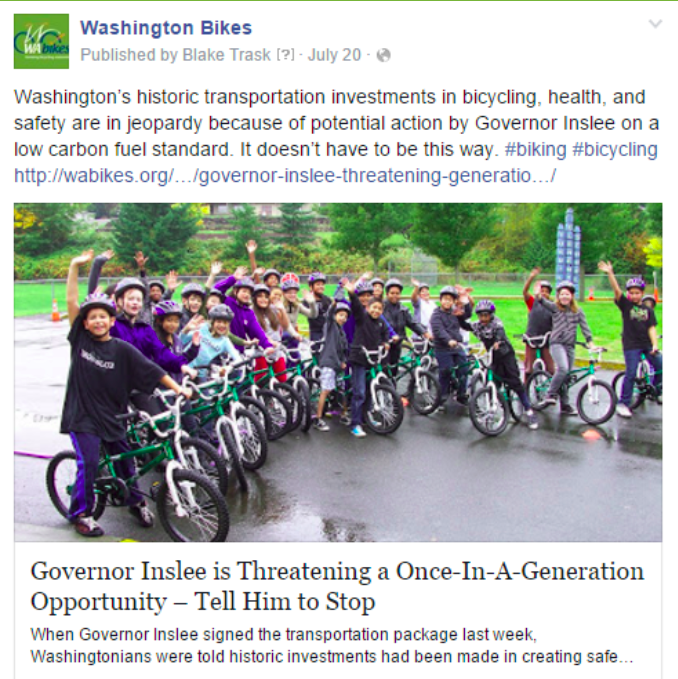
Good social can create fundraising cred: Social done well can entice followers to comment congratulations or kudos for your work. "This is social proof for you to then use in fundraising, in a grant proposal, in talking to a donor," Barb said. "Make use of it!"
Get other folks to spread the word: "Engage people in the co-creation of content, so they have some ownership in it," she said. "Then they'll have more reason to share it. If you say, 'We're helping you tell your story and you telling your story will help us get the resources we need,' will get more pass along."
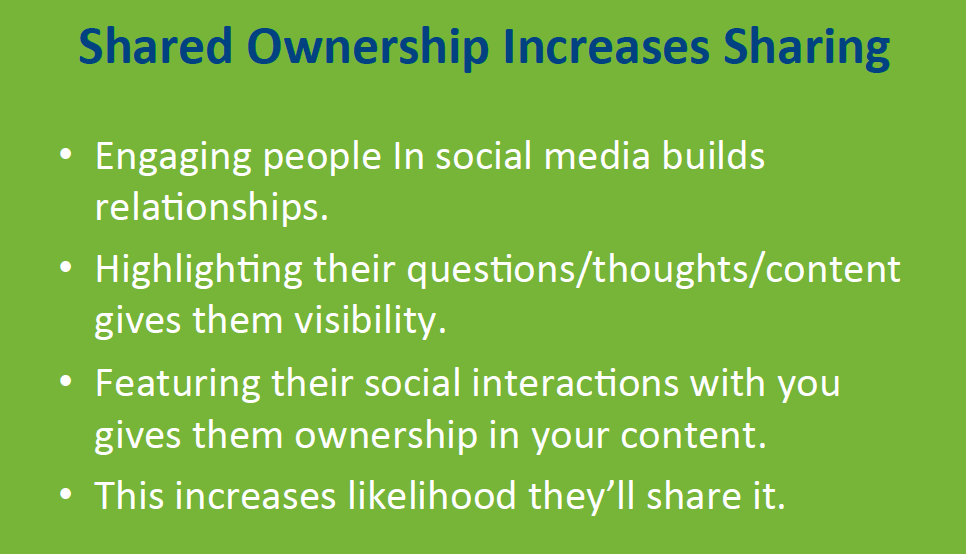
Social can be the start of a beautiful relationship: Even if folks don't click on a link in a Tweet and donate to your appeal, you're presence on social is about the most important asset for an advocacy organization: relationships. For instance, WA Bikes got into a dialogue with a rider on Twitter, which resulted in a guest blog. Lo and behold, at that year's auction, that Twitter follower became a financial supporter. "We drew him into this relationship through social media that resulted in him becoming a donor for the organization," Chamberlain says.
Take a (web)page out of Buzzfeed's playbook: When it comes to digital content, "everyone uses lists," Chamberlain says. "They're so over-done but they so work." How could that help your year-end appeal? A blog about your 2015 milestones? That turns into a list of reasons to give that your roll out on Facebook and Twitter — with great visuals, of course? Remember social is... social. "You can have fun reasons, too," Chamberlain said. "It doesn't have to be all serious, wonky stuff." Though, we wouldn't advise a zombie-themed appeal (though this was a huge hit for WA Bikes for Halloween!).


